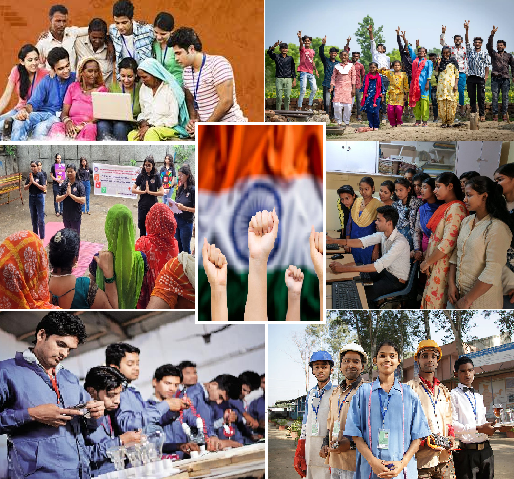
- The aspiration for the Indian youth is not to replicate protests abroad, but to find uniquely Indian ways of building the nation — through innovation, entrepreneurship, community service, and sustained democratic engagement.
- Indian youth hold immense potential in areas that go beyond resistance: entrepreneurship that generates jobs, social innovation that solves local problems, sustainable practices that protect the environment, and community initiatives that strengthen the social fabric.
- The true mark of leadership is not in how loudly one protests, but in how effectively one contributes to building a society that future generations can be proud of.
Youth have often been at the forefront of change worldwide — from the U.S. civil rights movement to European climate justice campaigns. Their voices have shaped debates, challenged complacency, and pushed societies forward. In South Asia, too, India and Nepal, two interconnected nations with shared cultural and political heritage, have witnessed youth taking to the streets.
But the contexts differ sharply. Nepali Gen Z has recently drawn global attention with its forceful demonstrations. This has sparked a debate: Should Indian youth emulate their Nepali counterparts? The short answer is no. India’s scale, diversity, and democratic framework demand approaches rooted not in confrontation, but in constructive participation. The aspiration for the Indian youth is not to replicate protests abroad, but to find uniquely Indian ways of building the nation — through innovation, entrepreneurship, community service, and sustained democratic engagement.
Nepal’s Path: A Price Too High
Nepali youth protests have gained global attention in recent weeks, especially after the “Enough is Enough” movement and the demonstrations against the government’s social media ban. Their cohesion and clarity of purpose were striking — the protests were issue-based and widely broadcast on social media. Yet, the tragic turn of events has also shown the heavy costs of agitation.
On 8th September 2025, what began as a call to lift the ban on social media platforms spiralled out of control when some protesters breached restricted zones near Parliament. The police responded with water cannons, tear gas, rubber bullets, and even live ammunition, leaving at least 19 people dead and hundreds injured. The incident drew international condemnation, with the UN human rights office urging Nepal to investigate violations of the right to life.
Though the government eventually lifted the ban, it came only after lives were lost and society was left scarred. This episode underlines a sobering reality: while protests may sometimes yield immediate concessions, the damage they leave behind (human, social, and political) is lasting.
Though the Nepal government eventually lifted the social media ban, it came at the cost of lives lost and deep divisions within society. Some have hailed it as proof that “democracy is alive” in Nepal — but the truth is more complex. A democracy that survives only through bloodshed and confrontation is fragile and burdened.
Lessons Not to Imitate from Nepal’s Gen Z
Indian youngsters must not follow the path of their Nepali counterparts. Street protests and mass uprisings may seem powerful in the moment, but they risk creating instability and division in the long run. India’s democracy, with its size, diversity and institutional depth, requires far more measured engagement. The real strength of the youth lies not in confrontation but in collaboration.
If there is anything to note from Nepal, it is not the form of protest but the emphasis on unity and clarity of purpose. Yet, in India’s context, those same qualities can and must be applied through constructive means — social service, innovation, entrepreneurship, education, and democratic participation. The goal should not be to disrupt, but to design and build. A movement of young minds committed to creation leaves a legacy far stronger than one rooted in agitation.
A Constructive Path for India’s Youth
India’s challenges demand long-term strategies, deep networking, and patience rather than quick-fire protests. With layers of decision-making and a vast political system, change in India cannot come from the streets alone — and certainly not from violent or chaotic uprisings.
Indian youth hold immense potential in areas that go beyond resistance: entrepreneurship that generates jobs, social innovation that solves local problems, sustainable practices that protect the environment, and community initiatives that strengthen the social fabric. By investing their energy in these positive, nation-building roles, young Indians can hold governments accountable while simultaneously helping India progress.
India’s young people, the country’s demographic dividend, are vast in number, brimming with energy, and deeply invested in shaping the nation’s future. The example of Nepali youth shows that collective voices can make governments listen — but India’s path must be different. For Indian youth, the real strength lies not in confrontation but in non-violence, unity, and constructive nation-building. By channelling their passion into leadership, innovation, and civic engagement, young Indians can create sustainable change that strengthens democracy without upheaval. If these principles are embraced, the youth will not merely seek to be heard; they will define what it means to lead a living, resilient democracy.
The true mark of leadership is not in how loudly one protests, but in how effectively one contributes to building a society that future generations can be proud of.
References
- https://news.un.org/en/story/2025/09/1165796
- https://amnesty.ca/human-rights-news/nepal-crackdown-gen-z-protests/
- https://www.hindustantimes.com/world-news/nepal-protest-live-updates-genz-protests-social-media-ban-army-nepal-curfew-kathmandu-new-baneshwor-parliament-101757325733234.html
Megna Devkar is a Ph.D. Research Scholar at K.C. Law College with research and writing expertise in social, political, and legal issues. Views expressed are the author’s own.
